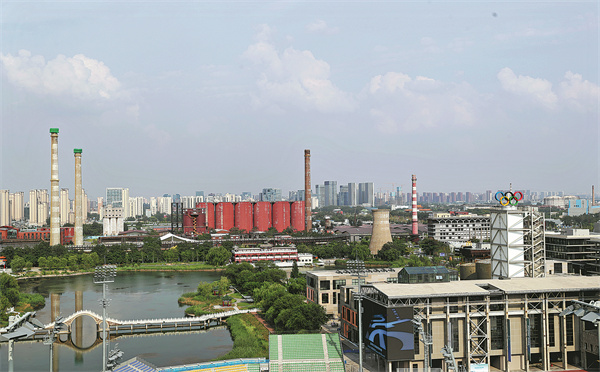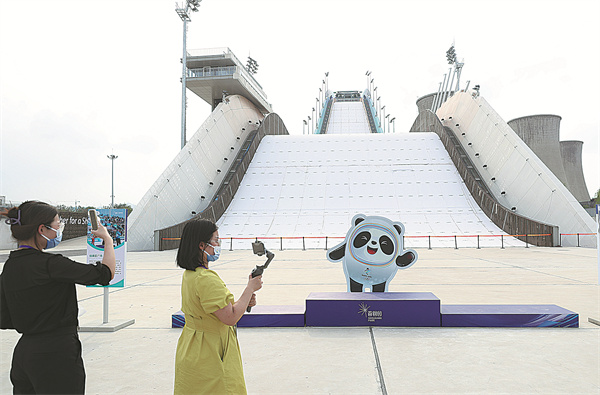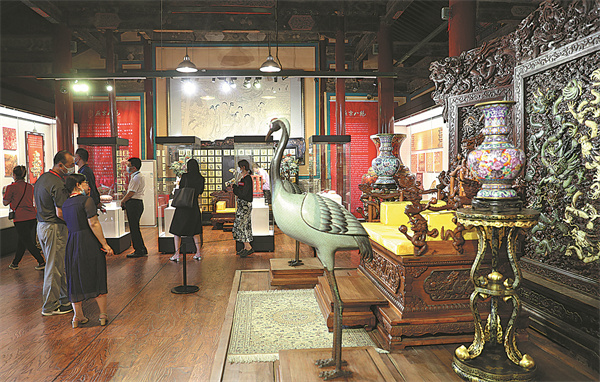New zone of creativity

Beijing's Shougang Park, once a State-owned iron and steel enterprise, has become a popular spot for tourism, sport and cultural events. [Photo by Zou Hong/China Daily]
If you like to explore culture, architecture and food on a short niche tour, a one-day getaway in western Beijing's Shijingshan district seems to be a good option. The district is working hard to protect its antiques and intangible cultural heritage, and to present them to the public.
Opened last year, the Beijing Eight Imperial Handicrafts Museum is dubbed "the city's most mysterious museum" by people online, because of the difficulty in making an appointment due to its daily visitor limit. The wait, however, is worth it.
During the Ming Dynasty (1368-1644), a special office was established to manufacture utensils and tools for the daily use of the imperial family living in the palace.
The office lasted through to the end of the Qing Dynasty (1644-1911), when the craftspeople had to leave the palace. They gradually developed "the Beijing Eight Imperial Handicrafts".
This refers to gold lacquer inlaid, filigree inlaid metal art, cloisonne, ivory carving, jade carving, carved lacquerware, Beijing embroidery and palace carpets.
Today, each of the eight handicrafts is listed as China's National Intangible Cultural Heritage.
Examples of these exquisite imperial handicrafts are on display at the museum.
Visitors will be amazed by the complicated and auspicious patterns on a mahogany box inlaid with gold lacquer, an ancient piece of ivory carved with small figures showing different vivid expressions, and various cloisonne items such as utensils.
At the handicraft workshops, some of the artworks are carefully arranged to present a view of the ancient lifestyle to which they belong. Visitors can also observe closely how these delicate artworks are carefully created.
"These handicrafts demonstrate traditional Chinese culture and aesthetics, with auspicious meanings," the museum's curator Bai Qun says.
They've hosted more than 500 cultural events over the past year, ranging from lectures to exhibitions, including some at schools and in local communities.
According to Bai, at some vocational schools, training sessions are held to introduce techniques for the eight handicrafts in a bid to foster future artisans.

Big Air Shougang, the venue for freestyle and snowboard events at the Beijing 2022 Winter Olympics. [Photo by Zou Hong/China Daily]
He says that the government attaches great importance to the protection of traditional culture, and the public has increased their cultural confidence and broadened their horizon after visiting different museums.
The Beijing Eight Imperial Handicrafts Museum is located in the 500-year-old imperial Cheng'en Temple, built during the Ming Dynasty. Emperors Qianlong and Daoguang of the Qing Dynasty ordered repairs to the temple on three occasions. Currently, the temple is, once again, undergoing repair and restoration.
It is said that the temple had three unusual rules since its completion, creating an air of mystery. The temple didn't open its doors to the public, didn't receive joss sticks or candles from believers, and Buddhist rites were not performed there.
Bai believes that the idea of establishing the museum in the temple is a creative one, combining the ancient architecture and the old handicrafts. While the temple is undergoing the aforementioned restoration work, the museum is temporarily closed, but is scheduled to reopen in early December.
About six kilometers away from the museum is the Shougang Park.
Between Aug 31 and Sept 5, the China International Fair for Trade in Services will be held at China National Convention Center and Shougang Park.
Once a State-owned iron and steel foundry, it has become a popular spot for tourism, sport and cultural events-most recently as one of the venues for the Beijing 2022 Winter Olympics in February. Big Air Shougang, which features a deep snow ramp, famously witnessed Team China's Gu Ailing and Su Yiming secure gold medals at the global winter sports showcase.
Shougang Park is popular among locals, thanks to its dining, sightseeing opportunities, handicrafts market and sports facilities. The park's typical industrial style is appealing to tourists, who can see exhibitions in the renovated blast furnace.
However, many tourists are drawn to the ramp after watching the Games.
By taking an elevator, you will be able to step on the top of the 60-meter-high platform within 30 seconds, with a stunning bird's-eye view of the whole park.
Like many other Chinese scenic areas, it sells popsicles that feature its iconic architecture. You can sample a yummy treat modeled on either the Big Air ramp or the blast furnace.

The Beijing Eight Imperial Handicrafts Museum has a collection of exquisite artifacts. [Photo by Zou Hong/China Daily]
Past and the present combine at the park.
The Shougang company was originally established in 1919, before the founding of the People's Republic of China in 1949.
It became China's key steel enterprise during the 1970s. In 2005, Shougang started the process of moving to Tangshan, North China's Hebei province, to ensure Beijing's air quality.
In 2015, an ambitious transformation project took place at the original site of Shougang, transforming it into an industrial and cultural theme park.
Beijing 2022 Winter Olympics offered the transformation of Shougang a new opportunity, renovating the factory with creative designs to build training centers and venues for athletes.
Walking on the 10-kilometer-long Shougang Skywalk, 14 meters above the ground, visitors can enjoy the old architecture of the original iron and steel enterprise such as the cooling tower, and the newly built commercial complex.
At night, the park is even more glamorous, with colorful lights, music, and a reflection of the architecture on the lake.
Food lovers can hang out with family or friends, sampling the barbecue and beer on sale at the stalls and taking a stroll in the park.
Sporty visitors can climb rocks, go skating or skateboarding, play badminton and basketball at the venues that operate until nighttime.
The park has also attracted corporations in the fields of sports, science and technology, and science fiction to set up bases there.
Liu Duo, an official from Beijing Shougang Construction Investment, says that the park offers preferential policies and themed events to draw tourists, and there will be over 50 restaurants in total in the park before the end of this year.
"Shougang Park is an iconic example of urban regeneration. You can see office buildings, former industrial facilities, and venues for international games. Our commercial services can ensure visitors from Beijing and other places have good experience here," he says.
























